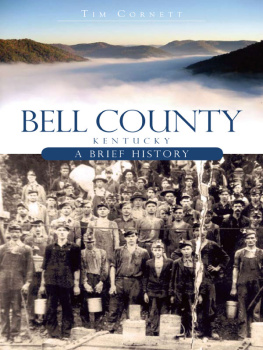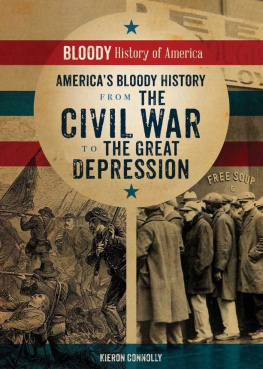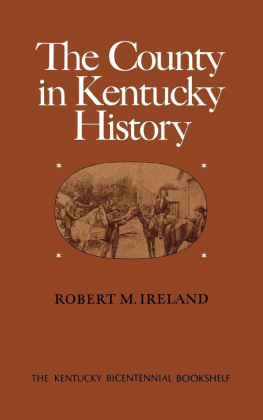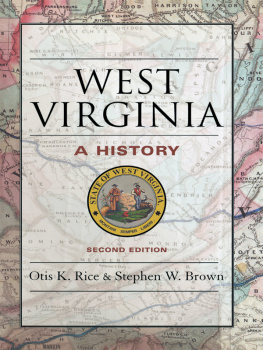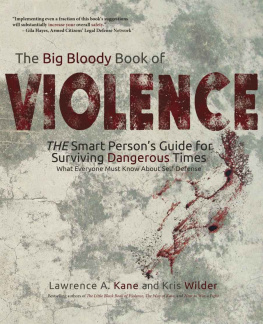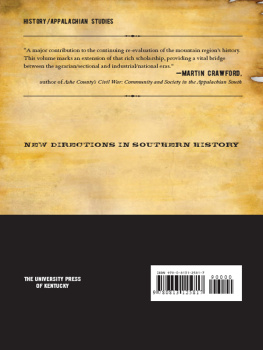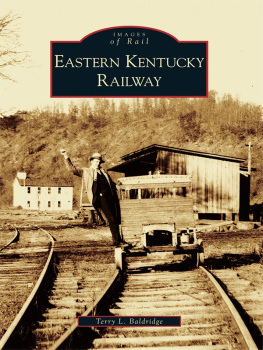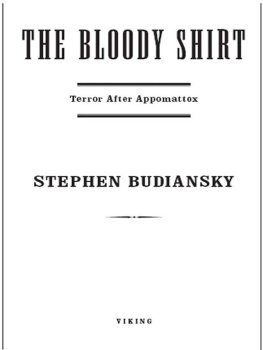Copyright 2013 by The University Press of Kentucky
Scholarly publisher for the Commonwealth,
serving Bellarmine University, Berea College, Centre College of Kentucky,
Eastern Kentucky University, The Filson Historical Society, Georgetown College,
Kentucky Historical Society, Kentucky State University, Morehead State
University, Murray State University, Northern Kentucky University, Transylvania
University, University of Kentucky, University of Louisville, and Western
Kentucky University.
All rights reserved.
Editorial and Sales Offices: The University Press of Kentucky
663 South Limestone Street, Lexington, Kentucky 40508-4008
www.kentuckypress.com
17 16 15 14 13 5 4 3 2 1
Library of Congress Cataloging-in-Publication Data
Hutton, T. R. C.
Bloody Breathitt : politics and violence in the Appalachian south / T. R. C. Hutton.
pages cm. (New directions in Southern history)
Includes bibliographical references and index.
ISBN 978-0-8131-3646-2 (hardcover : alk. paper) -- ISBN 978-0-8131-4242-5 ISBN 978-0-8131-4243-2
1. Breathitt County (Ky.)History. 2. Breathitt County (Ky.)Politics and government. 3. ViolenceKentuckyBreathitt CountyHistory. I. Title.
F457.B85H87 2013
976.919dc23 2013010408
This book is printed on acid-free paper meeting the requirements of the American National Standard for Permanence in Paper for Printed Library Materials.
Manufactured in the United States of America.
| Member of the Association of
American University Presses |
PREFACE
When I first decided to write about Breathitt County, Kentucky, I expected Id be writing a local study similar to most of the serious scholarship on Appalachia. What I discovered was a place where those in power needed violence in order to maintain their control, while those who refused to knuckle under to them saw violence as a tool themselves. These were flawed people, and even those who ended up on the right side of history got into that position by killing. Their stories were distorted by the language used to describe their actions without their verification. These are themes familiar to anyone who has studied Oliver Cromwell or Che Guevara.
In the half century after the Civil War Breathitt County was a violent place, but no more so than many other places in a particularly violent time period in a very violent country. I also discovered that different kinds of killing were damned or praised or tolerated according to the needs and wishes of powerful men.
Much of what went on in Breathitt County between the Civil War and World War I stands as an indictment of American exceptionalism. The United States of America maintains, at this writing, a republic with unparalleled longevity and stability. Americans should remember that this has required a tremendous amount of bloodshed. It also provides a commentary on how Americans separate past from present, here from there, and self from other. We like to admit our nation-states violence while pushing it further back into the past than it actually was, separating (in Hannah Arendts words) heritage from the dead load of atrocity. The history of the United States is full of atrocities and most of them Americans dont mind acknowledging, but without considering that their own past draws parallels with corners of the globe they consider less fortunate. (On that note, I apologize for any lapses into the jargons of anthropologists, political scientists, and others, but they serve the purpose of demonstrating that there are common currents of human activity that can be described without lapsing into lazy assumptions about progress and not progress.) When it comes to brutality, the United States is hardly exceptional. The savagery of la Violencia in Colombia, or the Troubles in Northern Ireland, has happened in the United States, even if Americans consider themselves above such things. Its no wonder that what went on in Breathitt County was dismissed as so many feuds.
From the moment I began my research I depended upon the support of others, especially an extraordinary publisher. The University Press of Kentuckys Anne Dean Watkins and Steve Wrinn are a skillful and patient editorial team. Their assistant Bailey Johnson helped me with technical details during the latter stages of my revising. Ashley Runyon and Mack McCormick helped me immensely during the early stages of promotion. Thanks also to Robin DuBlanc, an intricately perceptive copy editor. Bill Link, the New Directions in Southern History series coeditor, put me in contact with the press when my ideas for this book were in earliest bloom, and I still take that as a magnificent compliment. Finally, I appreciate Andy Slap and Bruce Stewart including my research in their anthologies published under the University Press of Kentucky banner.
Breathitt County, Kentucky, has its own dedicated native historians. Charles Hayess kind permission to reproduce photos from his collection for this book is greatly appreciated. Stephen Bowling and Janie Griffith run the countys two public historical institutions, its library and its museum, respectively. They each provided me with matchless perspectives on how their countys citizens interpret their past. Sherry Lynn Baker is a thorough researcher and she shared some valuable materials with me while also helping confirm a number of vital factual details. Thanks also to Jerry Buck Deaton for doing the same. John Robertson, the webmaster for Historical County Lines ( http://his.jrshelby.com/hcl/ ), helped me with the surprisingly formidable task of tracking down usable maps.
It is hard to imagine a state archive friendlier to a historians needs than the Kentucky Department of Libraries and Archives in Frankfort. In nearly a dozen visits I always received help and advice from its staff. The state capitals Thomas D. Clark Center for Kentucky History was also useful. The staff at Berea Colleges library was especially attentive and a credit to the schools tradition of a student-run campus. Lastly, Dean Williams of Appalachian State Universitys William Leonard Eury Appalachian Collection has always supported my research immensely.
Bloody Breathitt began as a doctoral dissertation, and I owe much to those who supported me in its completion. David Carlton is a ready adviser, a meticulous reviewer, a constant resource for southern lore, and a friend. Richard Blackett, once he read part of my beginning chapters, was an early source of encouragement, and his dissertation seminars had a huge impact on later chapters. He and his wife, Cheryl, have welcomed me into their home many times. Dennis Dickerson, Larry Isaac, and Rowena Olegario are challenging intellects that provided important criticism. Although he was not on my committee, my MA adviser John A. Williams might as well have been since he set me on a certain path years earlier. The Vanderbilt University Department of History provided a young southernist with bed and board, and a generous amount of funding. The departments administrators, Jane Anderson, Brenda Hummel, and Heidi Welch, always helped me when I was in need.


